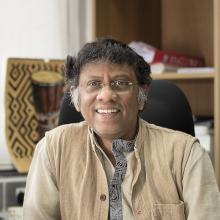For physicists, the general theory of relativity that explains gravitation has always stood apart from the theories that describe the other three fundamental interactions in the universe. While general relativity describes how spacetime curves in the presence of mass and energy, the theories that explain the electromagnetic, weak, and strong nuclear forces assume a fixed spacetime as a backdrop.
In the last few decades, string theory has uncovered a hitherto unsuspected connection between these two distinct sets of theories. This connection is called the ‘anti-de Sitter/conformal field theory correspondence’. It refers to a link between gravitation in anti-de Sitter space, a negatively curved spacetime, and quantum field theories that explain the other interactions in flat spacetime.
The duality refers to a prescription that translates between a gravitational theory on the anti-de Sitter spacetime and the quantum field theories on the edge of this spacetime, and vice versa. Studying one provides insight into the other. “It has become one of the powerful engines of contemporary theoretical physics,” said Professor Rajesh Gopakumar, who explores the intersection of string theory and quantum field theories. It has also helped shed light on mysteries like the black hole information paradox, added Rajesh.
What has long eluded precise mathematical description is the exact nature of the duality. A 2019 paper co-authored by Rajesh Gopakumar, Lorenz Eberhardt, and Matthias Gaberdiel offered a concrete example of the duality from both sides. “It helped us see how the correspondence works for a particular example,” said Rajesh.
The paper received the 2023 ICBS Frontiers of Science Award, announced during the inaugural International Congress of Basic Sciences in Beijing on 16 July 2023, which stated: “This work provides an exact and solvable example of the anti-de Sitter/conformal field theory correspondence, and affords a tractable worldsheet description of a tensionless limit in string theory.”
In addition, the work provides the first case of a concrete understanding of the tensionless limit. The tensionless limit in string theory exhibits the enhanced symmetries of string theory. “We have demystified the AdS/CFT correspondence, in this particular case, by deriving the duality,” said Rajesh. It has provided him and his collaborators a foothold to demystify the correspondence in other examples, in both higher and lower dimensions of spacetime. “For such a correspondence to hold, there must be a general reason. We want to uncover the hidden patterns underlying the correspondence,” he added.
The ICBS said: “The International Congress for Basic Science honors top research, with an emphasis on achievements from the past five years which are both excellent and of outstanding scholarly value. For the 2023 selection, scientific works in both basic and applied research are chosen in 34 areas of the three basic science fields (mathematics, theoretical physics, and theoretical computer and information sciences) represented at the ICBS.”
ICTS congratulates Rajesh and his collaborators and wishes them many more outstanding scientific contributions.


